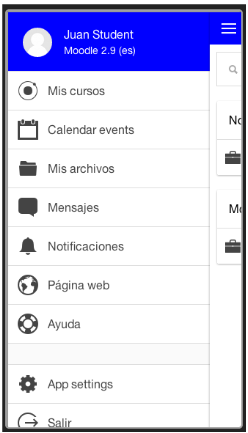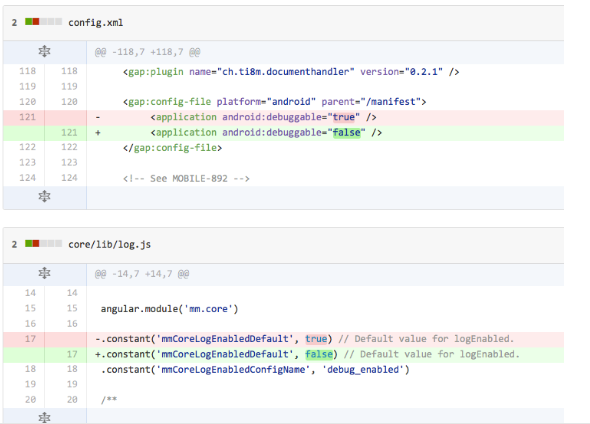Moodle Mobile custom apps
- Moodle Mobile 2 (Ionic 1) Customization
- Setting up your development environment for Moodle Mobile 2 (Ionic 1)
- Moodle Mobile development using Chrome or Chromium
- Moodle Mobile 2 (Ionic 1) Plugins Development
- Moodle Mobile 2 (Ionic 1) Themes
- Moodle Mobile 2 (Ionic 1) Developing a plugin tutorial
- Moodle Mobile 2 (Ionic 1) Developing a plugin tutorial part 2
- Moodle Mobile debugging WS requests
- Moodle Mobile 2 (Ionic 1) Remote add-ons
- Moodle Desktop
- Moodle Mobile FAQ
- Moodle Mobile End To End Testing
- See all Moodle App pages
- See pages for Moodle App Ionic 5 (current)
- See pages for Moodle App Ionic 3 (legacy)
- See pages Moodle App Ionic 1 (legacy)
- See pages for Moodle App Phonegap (legacy)
For user documentation see Moodle Mobile
| Warning: This page is no longer in use. The information contained on the page should NOT be seen as relevant or reliable. |
| Warning: This page is no longer in use. The information contained on the page should NOT be seen as relevant or reliable. |
Overview
You will need a custom app if you want:
- Force the users to log in to your site URL
- Custom corporate image (name, app icon, theme, store entry)
- Add additional features or static pages
- Remove or change existing features
- Custom translation of the app
- Use your own notifications infrastructure
Requirements
- Code editor (Sublime, WebStorm, Eclipse, Netbeans...)
- Github account (http://github.com/)
- Github desktop app (http://windows.github.com/)
- PhonegapBuild account
- Chromium browser as described here: Moodle Mobile development using Chrome or Chromium
Steps for creating your Custom App
Setting up your computer
Follow these guides:
- Setting up your development environment for Moodle Mobile 2
- Moodle Mobile development using Chrome or Chromium
Fork the app
Use the Fork tool in: https://github.com/moodlehq/moodleapp (You must be logged with your Github user!)
Clone the repo in your desktop
You can use your favourite GIT client (or GitHub Desktop clients)
Create a new branch
Having the code in a separate branch in the forked repository will make very easy to maintain our customizations using git tools (merge, rebase)
Edit the app settings file
/config.xml
- Change the widget id value (instead com.moodle.moodlemobile your own id)
- Change the app name and description
/www/config.json
- Change versionname
- Add a pre-fixed URL: Adding a field like “siteurl”: “http://mysite.abc”
- Change gcmpn (if you are using your custom Google Push infrastructure)
- Change the appid (required for making Push notifications work)
- Remove demo sites (“demo_sites”: “”)
Edit another app files
/www/core/component/settings/lang/x.json (x means all the languages)
- Change the “appname” string to match your custom app name (Not necessary in latest version Moodle Mobile 3.1.3), you can change it in config.json
/www/errorreport.js
- Change: var reportUrl to point to your custom error reporting system (if you want to use your custom one)
- Same for appVersion
Replace the app icons, splashscreen
- Replace the resources/ icon.png and splash images
- Replace also the www/img/moodle.png with an image matching your logo
- In a console:
- cd mycustomappdir/
- ionic resources
This will create your custom icon and splash images in all the required sizes
More information about Ionic’s image generation: http://ionicframework.com/docs/cli/icon-splashscreen.html
Add your custom styles
- Add your custom styles in scss/app.scss
- Sample theme available at: Moodle Mobile Themes
Building your Custom App
There are two options for building the app:
- Ionic CLI
- Local building (require installation of Android and iOs SDK and emulators)
- See http://ionicframework.com/docs/cli/run.html
- Phonegap Build
- Remote building (cloud service)
- This is the recommended way because it doesn’t require to install all the SDK, emulators (or having to buy a Mac for developing)
Building with Phonegap Build
GitHub
- First of all, you need to create a new repository in GitHub. This is because Phonegap Build requires a different directory structure than Ionic CLI and we need a branch per platform.
- In your forked repository, run gulp so the build files are updated.
- Copy all the code inside the www/ in your forked repository directory to this new repo/branch.
- Also copy the /resources directory from the ionic project to a new /resources directory in the phonegap build repository
- You also have to place the /resources/icon.png and /resources/splash.png you used to create your resource files in the root folder in the phonegap build repository
- Use this repository as an example:
github.com/moodlehq/moodlemobile-phonegapbuild/tree/learn-moodle - In the Phonegap Build repo root folder you need to add a special config.xml file (different to the Ionic one), use this file as a template. Please, replace there the app name, versions, etc.
- Then, in the Phonegap build repo you need two create two additional branches based on master: android and ios
- In the android and ios branch you need to apply these changes:
Disable debugging in the app:
Add android or ios base class (so the app use native style widgets):
- The rest of the commits can be safely omitted:
- Add reporting library
- Add official tag
Phonegap
- Create an account in PhoneGap.
- For iOS you need to create certificates/provisioning files.
- For Android, you can download and install the .apk for testing, for production follow the previous guide.
- In order to build, add your repository https link and also the branch in the Phonegap Build settings (you will have to do two different builds: one for the android branch and another one for the ios branch)
- In order to update your app for phonegap build you have to (this will apply all the specific android/ios commits to your master branch):
- Upload new versions of the app to the www/ directory and then execute the commands:
- git rebase master android
- git push -f
- git rebase master ios
- git push -f
Remove existing features
- You can only remove add-ons.
- In order to disable an add-on you need to delete the folder.
- Add-ons are located in the www/addons folder.
- In case you want to remove a particular functionality of an add-on you will need to edit the files inside the addon. Please notice that removing a state is not enough for a feature to be disabled, you also need to remove all the links to that state to prevent errors.
- Then run gulp or ionic serve in the project root folder so the build files are created.
Change the app strings
- Language strings are located in:
- www/core/lang folder (a different file for each language)
- www/core/components/COMPONENT_NAME/lang folder
- www/addons/ADDON_NAME/lang folder
- Language files are .json files, you can edit it using a text editor. Please, use jsonlint.com to validate that the new language file is correct.
- Then run gulp or ionic serve in the project root folder so the build files are created
Change the initial screen (add site)
- To make the app use a fixed site URL you need to add a new setting in the config.json file: “siteurl”: “http://yourmoodle.com”
- Then run gulp or ionic serve in the project root folder so the build files are created.
You can see an example from our Learn Moodle app (that is a custom version of Moodle Mobile) here: https://github.com/jleyva/moodleapp/blob/learn-moodle/www/config.json
Keep your custom version up2date
- Sync your fork: https://help.github.com/articles/syncing-a-fork/
- Rebase your changes (and resolve conflicts):
- git rebase master yourcustombranch
- Upgrade your version number
- Commit your changes
- Apply the changes in your Phonegap Build specific repository
- Rebuild with Phonegap build for both android and ios branches
- Publish in the store





